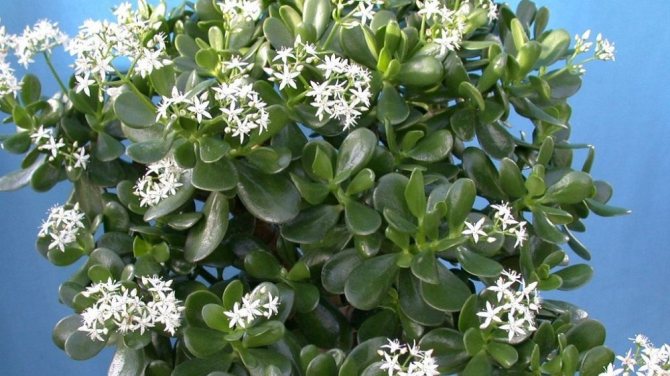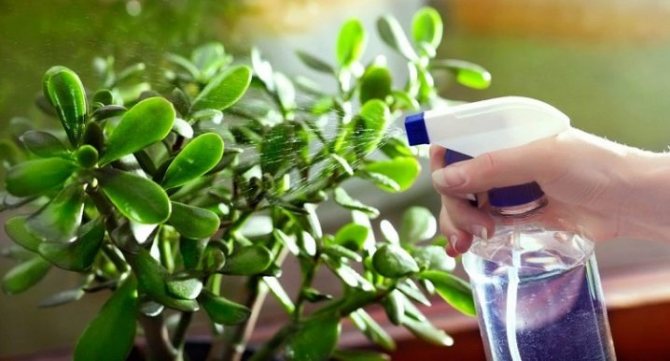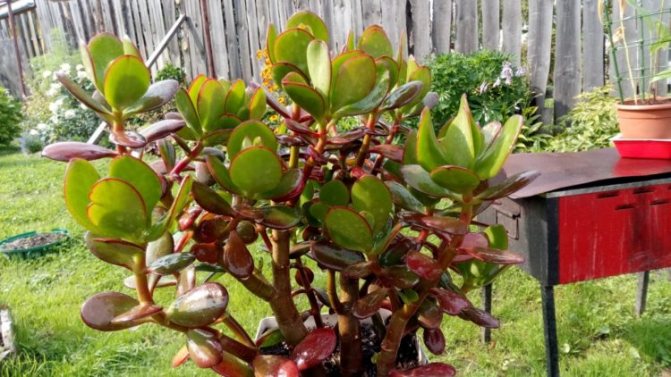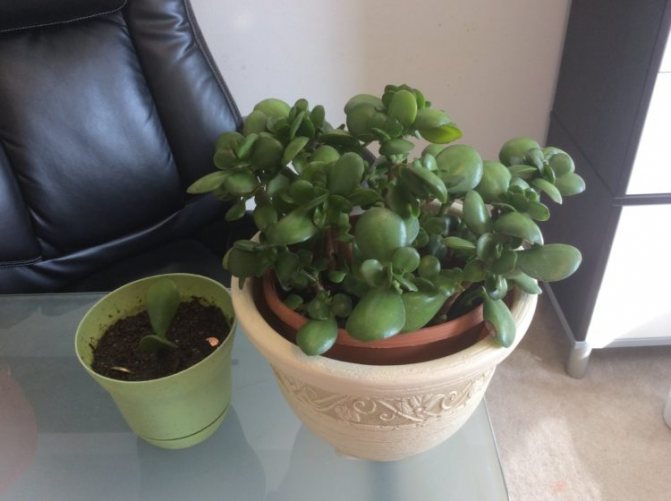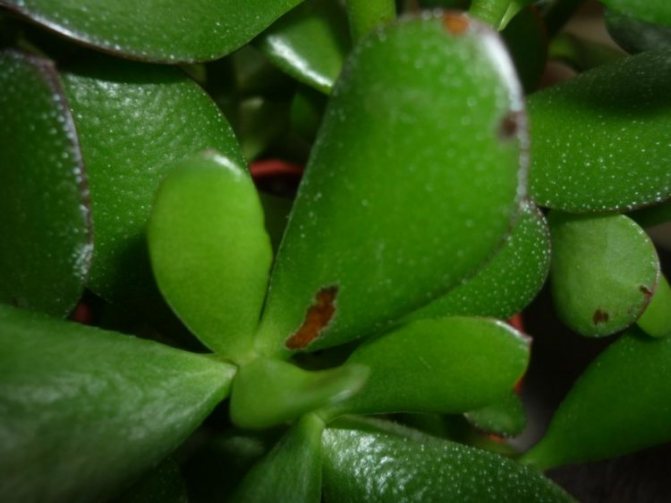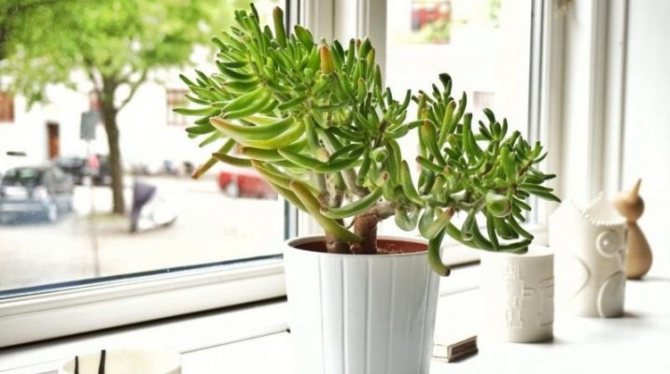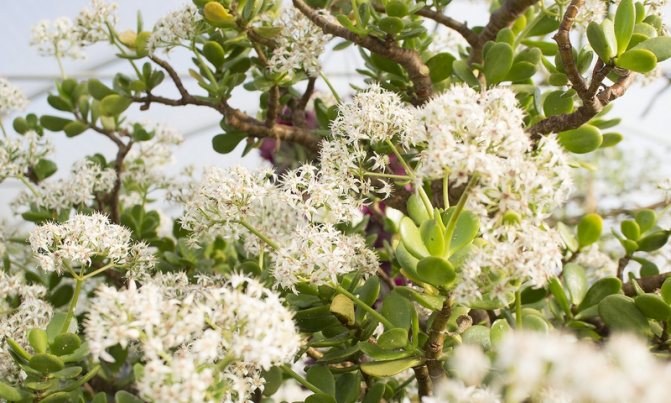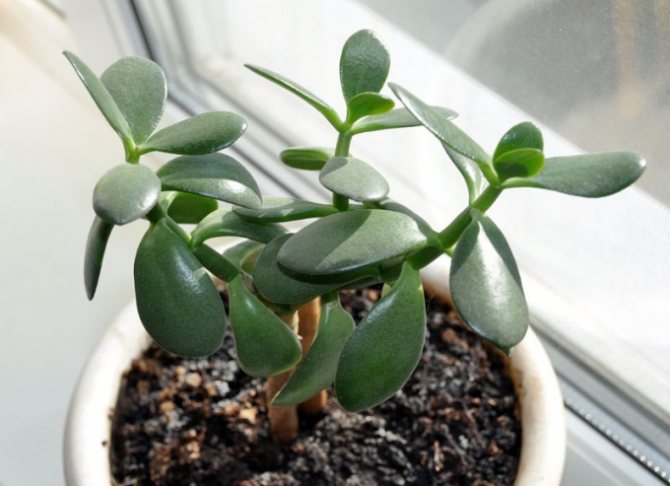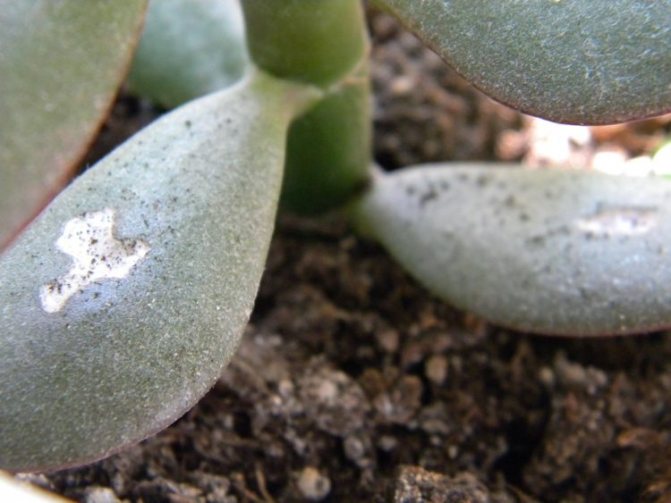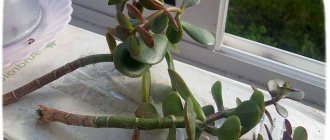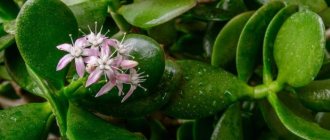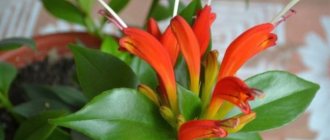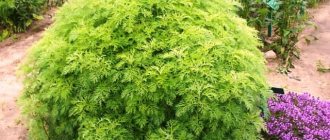There is a plant that has long been considered a symbol of prosperity and material well-being, as well as a neutralizer of negative energy and a focus of positive concentration. There are a lot of names for this flower, but the most common ones are fat woman, crassula (Latin Crássula) or money tree. The latter is due to its appearance, because the trunk of the plant really resembles the trunk of a tree, and the fleshy, densely arranged leaves look like small coins. The flower is considered very unpretentious, therefore, caring for a money tree at home will be within the power of every amateur florist.
Causes of leaf fall
There are many reasons that lead to a disastrous result.
Plant age
We immediately exclude the features of an adult plant, since it has been established that the leaves die off from below on old woody branches. This process is normal if periodically several leaves fall off, and juicy, young and strong greens grow to replace them.
Prolonged absence of a transplant
The next reason is the need to transplant a plant. If the "place of residence" of the money tree has not changed for a long time, then conditions unfavorable for its normal growth and development are created, the soil is depleted.
Transplanting can be a serious stress for the plant, which it will respond to by shedding some of the leaves. Try not to damage the root system of the flower. Or give preference to transshipment.
Violation of the watering regime
Falling leaves can be caused by insufficient watering
It is important to remember that this is a succulent plant that does not need frequent watering and has special tissues on the leaves to conserve water reserves. Abundant watering provokes the appearance of mold in the soil, leading to rotting of the root system. Insufficient watering entails drying out of the earthy coma, loss of elasticity by leaves that turn yellow and fall off.
Direct sunlight
Exposure to direct sunlight adversely affects the leaves of this flower, since its green mass has a rich color and a thin epidermis.
Excess mineral fertilizers
Dying off of tissues and disturbed vegetation processes can be the result of an overdose of mineral fertilizers.
Abnormal temperature of water used for irrigation
By using cold water when watering, you create a difference between the temperature of the roots and foliage. This is fraught with a slowdown in metabolic processes in the root system and active leaf fall.
The presence of a disease
This plant is very attractive to pests, therefore, the loss of decorativeness is often caused by the harm that causative agents of various diseases have managed to inflict.
Incorrectly selected substrate
Crassula needs light, not too nutritious soil that is good for moisture and air. If the soil is heavy and contains a lot of humus, the culture will slow down growth and lose its decorative appearance.
Decision. The soil must be replaced. Use a succulent substrate. You can prepare the mixture yourself: take two parts of peat, turf and leaf soil, three parts of coarse sand. Lay a drainage layer three to four centimeters at the bottom of the container.
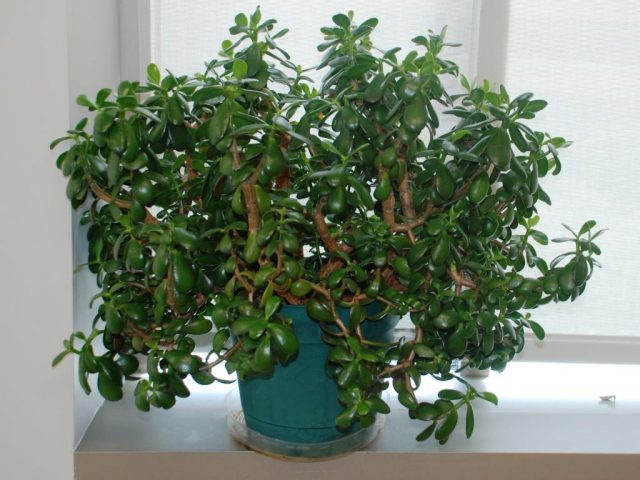
How to eliminate the causes of leaf fall
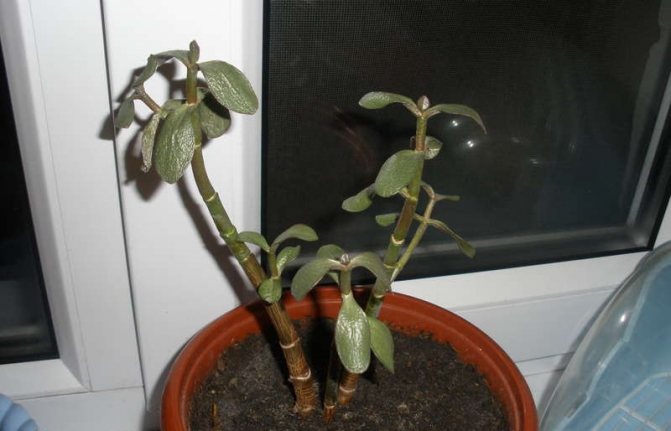

There are a lot of reasons for the leaves falling off the money tree
- If the plant has reached a mature age in which it has no potential for development, then, unfortunately, only cardinal pruning for the purpose of rejuvenation can help crown and the appearance of new shoots.
- Eliminate cramped conditions for the root system of a flower - transplant the money tree into a larger pot, filling it with drainage and soil suitable for succulents. The enriched soil will allow you to revive your pet.
- Adjust the watering mode. This is easy to achieve, it is enough to apply the knowledge of watering succulents at different times of the year. The money talisman prefers moderate watering, therefore, in the fall and winter, it is carried out as needed, when the soil dries out. More often in summer and spring.
- Exclude exposure to direct sunlightthat cause leaf burns, use shading as a defense.
- Feed mineral fertilizers very carefully, observing the recommended dosage and frequency. It is advisable to feed the money tree with special fertilizer in the spring-summer period (April-September). Not more than once a month.
- Use water for irrigation room temperature, first boil it or stand to get rid of hardness and chlorine. This is the standard rate that prevents stress and plant death.
- Diagnose flower diseases in the early stages, regularly carry out preventive sprays.
The foliage of this plant has the ability to retain moisture, which is wasted during a lack of water. Therefore, drought is better tolerated than waterlogging or stagnation and excess fluid.
The fat woman is slowly growing: reasons and solutions
The money tree is a succulent that develops slowly. During the season, the culture can add three to five centimeters in height. In winter, Crassula "rests" - its growth slows down or stops altogether. Therefore, do not expect the tree to grow twenty to thirty centimeters over the summer. No one can change this, since the fat woman has such a physiological process.
But if your tree has not increased in size at all and its appearance is completely unattractive, think about it. Perhaps the plant does not like how it is looked after, or it is attacked by pests.
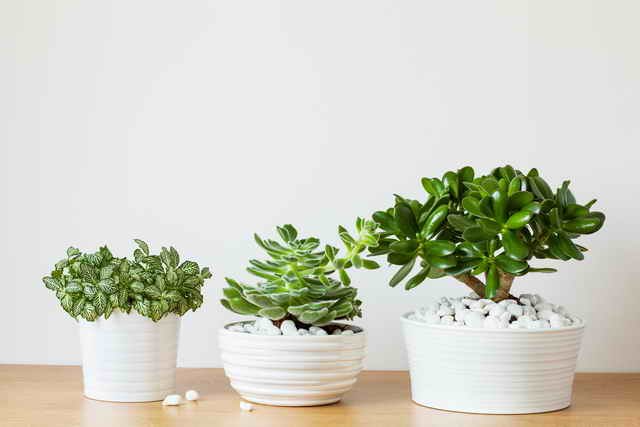

The fat woman is slowly growing. Illustration for this article is used under a standard license.
Why does the appearance of leaves change?
The softening of the leaves is caused by decay of the root system
Professionals see the reason for the appearance of sluggish and wrinkled foliage in improper care and violations of agricultural culture. Excessive watering starts decay processes, as a result, soft leaves fall off.
An incorrectly sized pot prevents the harmonious development of roots, drafts, lack of lighting or an excess of it - all this leads to wrinkling of the leaves.
The reason for the appearance of yellow leaves lies in the need for additional lighting. What if the leaves turn yellow and fall off? Create conditions under which the tree will receive a bright diffused light, carry out additional lighting.
Lack of lighting
The fat woman is a lover of bright, but diffused lighting. If it stays stably in shady conditions, its growth will slow down, the foliage will become small, the stems will begin to stretch.
Decision. Place the plant on the southwest or southeast window. If this is not possible, shading should be arranged on the southern windowsill to avoid burning the foliage.
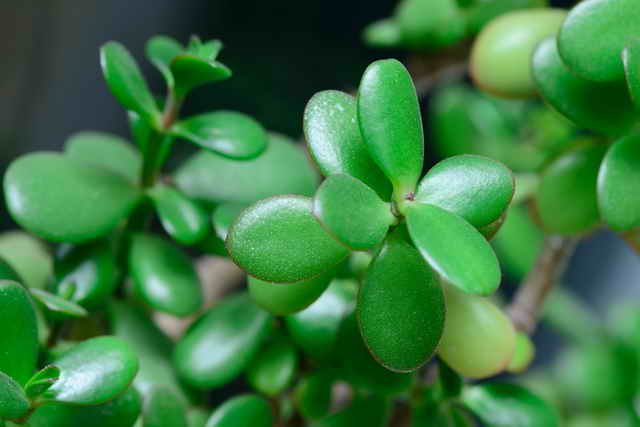

Illustration for this article is used under a standard license.
Following our advice, you can easily understand what exactly interferes with the active development of your pet. We hope that Crassula will be able to delight you with its active growth!
Signs associated with falling leaves of a money tree
Since among the people this plant symbolizes financial wealth and prosperity, then all the signs are associated with the material sphere. Therefore, the loss of leaves can theoretically lead plant owners to losses of various kinds. A money talisman with a lot of shoots attracts and activates the flow of wealth. To maintain material well-being at a high level, it is required to create a favorable environment for a houseplant. But there is a completely opposite opinion: fallen leaves are perceived and used as a serious talisman that attracts money. They need to be collected and sewn into a bag, which should be assigned a secluded place in the wallet.
Fat woman is a plant with strong energy, at the level of the biofield associated with the inhabitants of the house in which it grows. It is often the case that simultaneously with the illness of the physical or psychological owners, a flower falls ill. The psychological discomfort prevailing at the location of the plant also has a negative impact on the state of the money tree. The fat woman expresses a kind of protest against the negative with massive leaf fall. So that your pet does not wither, pay attention to your energetic connection with him.
Reproduction of the fat woman in various ways
Most often, the reproduction of the money tree is carried out by cuttings, since this is the easiest and most reliable way, for which the season does not play any role.
It is more convenient to propagate the bastard immediately after trimming or pinching the crown, since there will be enough planting material in stock.
There is no need to talk for a long time about how to plant a shoot. It is better to dry the cuttings for several days, and then plant them in the ground. You can put them in a glass of water first for rooting. The appearance of roots on the cuttings indicates their readiness for planting in separate containers. It is better if the shoots are taken from a plant, at least 3 years old, and have four leaves.
You can also propagate the bastard with leaves and even seeds. To grow a new plant from a leaf, you need to choose a large, not yellow specimen, carefully cut, dry for 1-2 days and plant in a container with a substrate. It will take about 2-4 weeks for rooting.
The seed method is used by breeders to breed new species. It is recommended to sow seeds superficially in moist soil. The best time for this is the end of winter. The containers should be covered with foil. After emergence, the greenhouse is gradually removed, accustoming young plants to room temperature.
Money tree pests
The fat woman is often affected by scabies.
Plant parasite scale insect shows its presence on the plant by the presence of yellow or brown spots. This sap-sucking pest is difficult to recognize. Before starting treatment with a chemical, infusion, they must be removed from the plant manually. Treatment with infusion of garlic, laundry soap, kerosene has a positive effect. In difficult situations, insecticides are used. The stem and leaves are sprayed.
Spider mites reveal their presence by the appearance of a thin cobweb. It is necessary to shower the aerial part of the plant and the use of chemicals.
Mealybug leaves a white cocoon in the leaf axils of the flower. If detected, manual collection or removal with a stream of warm water and treatment with an insecticide is mandatory.
Root worm - a parasite that lives on the roots in the ground, in the fight against which the roots of the plant should be washed with water and once a week, spilled with an insecticide solution for two months.
Filamentous worms form swellings on the roots. Outwardly, this does not affect the flower in any way, but the tree slows down growth, with a serious lesion, it can stop developing.Trimming of the damaged part of the root system is required, antihelminthic drugs are used during watering.
Thrips located on the lower parts of the fat woman, are dangerous in that they are carriers of viral diseases. The fight against this pest should be carried out with the help of chemicals.
Aphid the money tree is affected by wrinkling of leaves and curvature of branches, which dry up and fall off. Washing the tree with detergents has proven itself well.
Red-brown or yellowish spots on the leaves of the bastard
Brown, brown and white spots on the leaves of Crassula indicate a plant infection with a fungal disease. Treatment of a fungal infection at the initial stage must be carried out with fungicides, strictly following the instructions for use of the drug.
The scutellum is a small insect (up to 5 mm) covered on top with a shield similar to the shell of a turtle. They settle on the leaves, trunks and petioles of the plant. When damaged by this pest, the fat woman quickly weakens. The leaves are first covered with spots, then turn yellow and fall off. If you do not start treatment on time, then the plant can be lost.
Diseases of the money tree
Most often, the money tree is affected by fungal and bacterial infections.
This culture is most susceptible to fungal and bacterial infections, which are activated in unfavorable conditions for keeping a flower, in violation of the recommended rules of care. A feature of gray, wet rot is active distribution in a short time and the defeat of the entire flower, which is covered with brown or brown spots. Emergency measures include reducing watering, removing affected parts, and spraying with fungicide.
Bacterial rot provokes various bacteria in the money tree, which are eliminated with aqueous solutions of antibiotics and fungicides.
During the period of rehabilitation and treatment, the plant especially needs to create sufficient lighting, reduce the humidity of the air and soil, and ensure the optimal temperature regime.
Flower diseases
A money tree can get sick with fusarium rot - with abundant watering and violation of other rules of care. Treatment is carried out with a suspension of foundationol at the rate of 2 grams of funds per 1 liter of water and a transplant.
Spots of brown or yellow color on the foliage are a signal of the defeat of the flower by a fungal or bacterial infection. A complex drug is used for treatment.
Black spots on the surface of the leaves, which become soft, are the result of severe sunburn. Take care of your pet's protection.
If the leaves of the plant are deformed, then it may not have enough moisture. With a lack of moisture, they can also dry out.
In the autumn-winter period, from a completely healthy Crassula, leaves can fly around. Then it should be transferred to a light window sill or additional artificial lighting should be applied.
A silvery coating on the surface of the foliage should not scare flower growers - this is a normal physiological process. But a white bloom indicates a mite infection of the culture. If it smells like mildew, it is most likely a fungal infection called powdery mildew. In this case, treatment with "Fitosporin" or "Fundazol" will help. If there is no smell, ticks attacked your pet. Then, for treatment, you will need Fitoverm or Aktara drugs.
If the plant withers, the root system may rot. The salvation will be transplantation and placement in diffused light. In the first month, watering should be carried out from the pallet and in small quantities.
In early spring, foliage may turn red. It is associated with a violation of the process of photosynthesis. To make the leaves turn green, the pot must be removed from the illuminated windowsill into the back of the room.
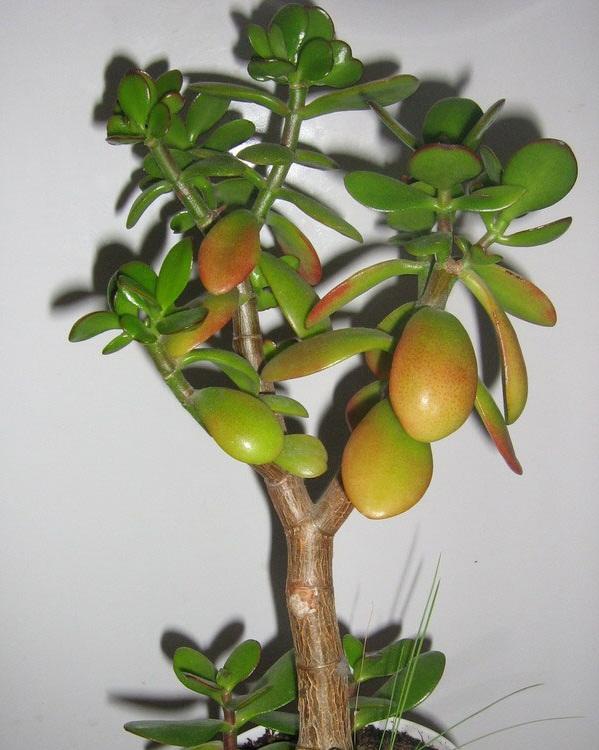

When Crassula leaves are too small, it may lack lighting or nutrients. Then you will need a feeding for succulents, in which phosphorus and potassium contain less nitrogen.
Recommendations of professional florists
Samarina Irina Petrovna: “Do not ruin your fat woman with unnecessary care, because everything needs a measure. Then the money talisman will be strong and healthy. "
Smirnova Tatyana Petrovna: "Use specialized soil and fertilizers for succulents, so as not to harm the excess or oversaturation of various substances and microelements."
Dudenko Vladislav Stepanovich: “Reduce winter watering to 1-2 times a month. It is preferable to reduce the temperature in the room to fifteen degrees, because at this time in the homeland of the money tree there is cold dry weather. Focus on the season when choosing the frequency of watering and optimal temperatures. "
Disease symptoms
Any flower living indoors is in unnatural conditions. The plant must live in the wild.
It is impossible to create this thoroughly at home. Therefore, the culture begins to react to unsuitable conditions with appropriate external signs.
Poor development
The slow development of the fat woman is for the following reasons:
- bad light;
- insufficient drainage;
- poor watering during active growth;
- there is no coolness during the rest period.
If these factors are eliminated, growth will increase. To form a lush crown, shoots are pinched. This stimulates growth points.
The right balance of lighting is needed for the rapid development of the money tree. The fat woman loves light, but does not tolerate direct sunlight.
Falling leaves
Considering that Crassula reproduces with leaves, their shedding indicates that the conditions are unfavorable. If the plant sheds its leaves, then it is about to leave offspring. The leaves of the money tree fall for the following reasons:
To prevent foliage from falling off the branches, you need to water it with settled water. Fertilizing the soil in moderation will reduce the number of leaf litter. In winter, the number of waterings is reduced to 1-2 per month, and the room temperature is maintained at 15 degrees.
Rotting trunk
The plant naturally grows in an arid climate, so it stores moisture for future use. If the soil has been overly watered, then the trunk and root system will begin to rot.
If this happened, then the flower needs to be transplanted urgently. For this, the root system is examined, the affected areas are removed, and the surviving ones are planted in the ground. The new plant begins to grow.
It is impossible to reanimate and save a rotten barrel.
Leaves turn yellow
Often the money tree pot is placed on a north-facing windowsill. The yellowing of the leaves occurs due to insufficient lighting. If the leaves turn yellow and dry, you need to pay attention to artificial light.
In summer, the best place for crassula is a loggia or a garden. Moderate humidity and lighting are provided here.
Yellowing of leaves
Leaves are limp and soft
If the leaves become lethargic, soft and thin, and the money tree withers, then the problem is improper watering. The root system does not withstand both dryness and waterlogging. The soil must be well drained.
The plant is affected by solar insolation. If the culture has just been transplanted, the root shrinkage process may take place. The moisture that is present in the soil is not enough for them.
Black spots on the leaves
Black spots on the leaves appear as a result of sunburn. Over time, they crumble. This is due to a fungal disease. It is better to immediately remove all the leaves, and treat the trunk with the drug. New growth points will appear at the pinching site.
Ventilation of the room will help to cope with such a problem, since the cause of its occurrence is high humidity.
Black spots on the leaves
Reddening of the leaves
Redness is caused by bright sunlight. They also turn red from moving the pot from a shaded place to a sunny windowsill. As soon as the leaves turn red, you need to hang a curtain on the window. After that, they will soon turn green. Sometimes the leaves turn red on the underside. This is due to insufficient watering.
In case of reddening and wilting of the leaves, when they are wrinkled, this means that a sunburn has occurred. The money tree is treated with biostimulants, such as Epin.
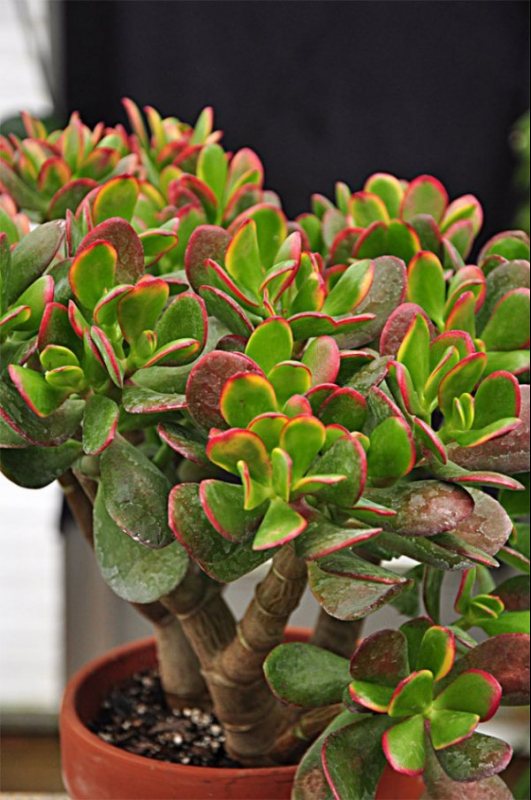

Reddening of the leaves
Signs of a sick plant
The money tree in most cases, if it is affected by any disease and there are errors related to care, will signal the grower about this with changes in appearance.
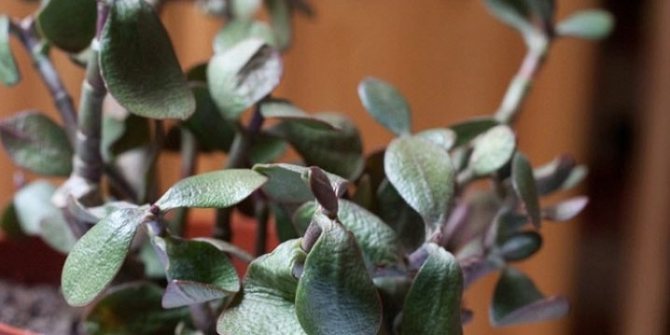

Leaves
The fact that the tree is sick will be indicated by the dropping of leaves. This is not the case when the adult culture is renewed in this way. If Crassula has dropped all the leaves, while new ones also die off underdeveloped, it is required to start looking for the cause of this behavior as soon as possible. If culture leaves become wrinkled, which means that the plant does not have enough moisture, dark spots indicate that the tree has been burned. White dots and plaque - signs of a tick on the plant.
In a money tree, foliage can slightly change color in bright indoor lighting, then the edges of green leaves will acquire a reddish tint. A decrease in size will indicate a deficiency of beneficial micronutrients. To maintain culture, it will take potash and phosphorus fertilizing. Also, the state of the crassula leaves will be affected by the stress that the plant could experience during the growth process. Most often this concerns watering the succulent with cold water, after which the culture withers, the leaves lose their turgor. The money tree withers from an unsuitable rooting container - if the culture is too crowded in it, this will affect the appearance and health of the green mass.
Black leaves indicate that the plant is suffering from severe sunburn, or the crop is suffering from an infection. In the first case, it will be necessary to change the location of the fat woman, in the second, an examination of the entire culture should be carried out, and treatment and fight against the disease should be promptly started. As a rule, it will be possible to distinguish one situation from another with the help of a visual assessment of the places of blackening: if they are in hard-to-reach places, it means that the plant is infected with bacteria. Mealy bloom, the concentration of which falls on the axils of the leaves, will indicate the presence of pests on the culture, most often, such traces are left by a mealybug.
If the crown turns yellowthen the indoor culture suffers from a lack of sunlight. To prevent the tree from drying out and falling, the indoor succulent will need to be provided with 12-hour daylight hours.
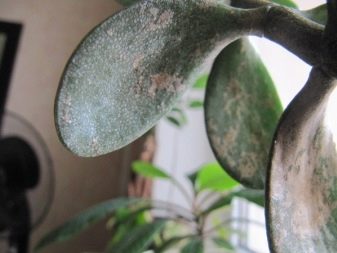

Trunk
With abundant moisture and stagnant moisture in the fat woman the trunk may become soft... The tree can fall on one side, and the plant will react with excess moisture in the soil. So that it does not break, it is worth reducing watering, making a temporary support for the Crassula. After a while, the plant should get stronger and level again.
Read also: Tomatoes spasskaya tower reviews photos
Changes in the trunk of a money tree can be observed with a lack of light, in which case the plant lengthens and becomes too elongated, abundant watering can also provoke such growth, most often problems of this kind arise in winter. If you rearrange the fat woman on a lighter window sill, then the crown can be made lush in a fairly short time. In order for the succulent not to grow one-sided, it is recommended to turn it periodically.
If the culture has stopped growing for a long time, you should change the pot for it, since the one currently available is too large and wide for the plant, in light of which it put all its energy into developing the root system.
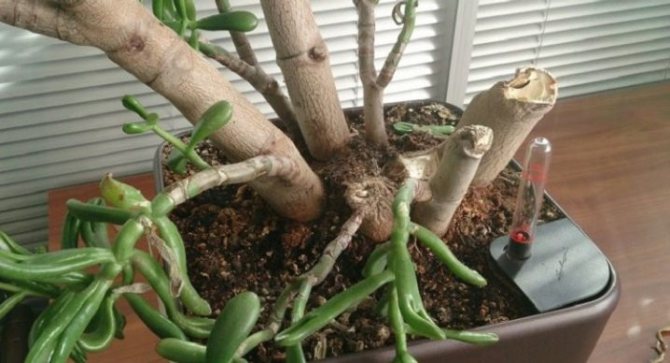

Roots
Root system problems can be found when transplanting a money tree. If the roots are rotten, then the grower should promptly take measures to save the culture, since such a plant dies very quickly. In order to save a houseplant from death, it is necessary to remove the damaged segments of the rhizome and keep the fat woman in a weak solution of potassium permanganate for disinfection.
The soil from the pot is also subject to replacement, the container itself should be treated with soapy water.
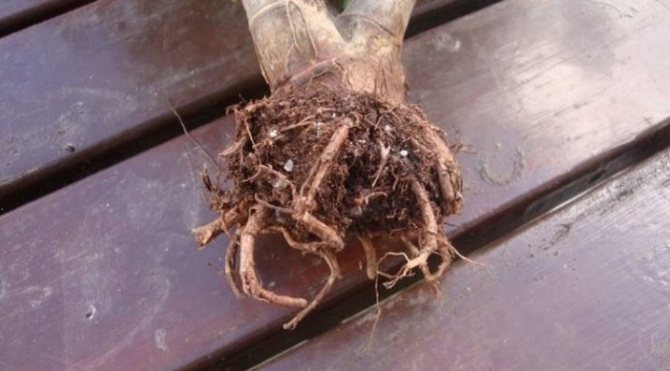

A plant native to arid Africa
Crassula has several names: "Monkey tree", "Zhiryanka", "Fat woman", but more often the name, which will be discussed, is "Money tree". The Latin name "Crassus" means "fleshy", "thick". The homeland of the plant is Africa and Australia.
It is a perennial and evergreen plant in the form of a tree with a thick trunk that grows stiff over time, with many fleshy leaves resembling coins. At home, it reaches 1.5 m, and in nature it is found up to 3 m in height.
You should not buy a money tree already grown by someone. This will not bring the desired effect and benefit. The tree must be grown from the cutting itself, to take care of it, to love it. Work on the crown of the flower should be started with a small sprout. The tree grows, pleasing the eye and touching the soul, and we carefully remove the lateral sprouts. When the trunk reaches the desired height, we leave several branches and continue the formation of the crown.
Our money tree is an unpretentious plant, it does not like great care. As experienced flower growers say: "Leave the plant alone." But it's still worth knowing and following the basic rules of caring for him.
The most common trouble that can happen to our tree is leaf fall. Let's try to figure out the reasons why the money tree drops its leaves, and find out what to do in such a situation.
The leaf becomes lethargic and becomes covered with black spots.
Signs of plant death
:
- The very first and sure sign is the dropping of leaves. An adult money tree can periodically shed leaves from old branches, but if the process has engulfed the entire plant, and new leaves die off, Crassula must be saved.
- The trunk of the plant has become soft and flabby - this is also a sure indicator of an excess of moisture.
- The appearance of dark spots on the leaves indicates that the money tree has received a sunburn.
- Leaves dry and wrinkle - and this is already insufficient watering. Check the soil moisture level often!
- White bloom on the leaves is an indicator of the appearance of a tick. If it smells like mold, it's powdery mildew. Treatment required.
Not to be confused with a light silvery bloom that appears on old leaves as a result of abrasion of the skin of the plant! - Leaves may turn red. Do not be intimidated by this - as a rule, this happens in bright light. It is enough to remove the plant away from the window and the green color will be restored.
- Too small leaves indicate a lack of nutrition. The problem is solved by feeding, while the content of phosphorus and potassium should prevail over nitrogen.
The reasons for its withering
Causes of plant wilting:
- Watering
... Excessive watering causes root rot, leaf fall and plant death. Remember, the fat woman is a succulent! Lack of moisture is safer for her than excess. - Heat
... Prolonged heat can also cause leaves to drop. After a while, they will grow back. The difference from the first case is that the stem retains its firmness and juiciness. Fallen leaves have a yellow tint. - Sun deficiency
... During the period of sun deficiency (autumn - winter), the plant may be sick due to lack of lighting. Try to keep the money tree in the lightest window, or use artificial lighting. It is strongly advised not to keep the money tree on the north side. - Diseases
:- Fusarium rot - the disease is also a consequence of excessive watering. Decay of horses occurs, the plant becomes flabby and lethargic. Young shoots die off quickly.
- Various fungi and bacteria cause brown, yellow spots to appear on the leaves. Such leaves should be removed, the plant should be treated with special preparations.
- Powdery mildew - a whitish coating that affects leaves, has a moldy smell.
- Pests
:- Scabbard - appears in the form of yellow and brown spots on the leaves.
- Spider mites are small white or red bugs. Small yellow dots first appear on the leaves, then dry brown scabs.
- The mealybug resembles white cotton wool on the roots or leaves of Crassula.
- Thrips - strikes in summer in hot weather. The leaves turn yellow and fall off. The plant is strewn with small oblong bugs.
Why does the fat woman turn pale and fall off the foliage?
Answer the question why fat woman is losing leaves is not difficult... Several options are possible. Typically, this happens either from underfilling, or from waterlogging, it is also possible your the plant is stressed and thus reacts to it. With the first two cases, everything is clear: if you too rarely watered your pet, then it’s a drought, if you have constantly wet soil and it does not dry out, then you flooded the plant.
The solution to the problem is to adjust watering and reduce feeding.
But what the plant can experience stress from is not entirely clear. The most likely reason is watering with cold water... Do not forget that the Fat Woman is still a tropical plant and a cold shower is not at all for her.
The solution to the problem is to water the Fatty Woman with settled water at room temperature, and preferably warm.
Rotted trunk:
Why does the money tree have a soft, thin trunk?
Succulents, which include the Fatty Woman (money tree), accustomed to storing water for future use in the desert, do not tolerate excessive soil moisture at all. Roots begin to rot, and behind them the trunk of the plant. If, after drying the soil, the plant has not returned to its proper form, then everything is very serious - it urgently needs to be replanted. How to save and what to do if the trunk rots, the roots rot and the money tree (fat woman) dies? Before transplanting, you need to wash off the soil from the roots and carefully examine them. If everything is not so bad, and only the roots are rotten, they are cut to healthy areas, powdered with wood ash and planted in a new substrate. It is almost impossible to reanimate a decayed trunk. Stem cuttings of the Fatty Woman take root very easily, and the new plants that you grow from them will help to correct the mistakes.
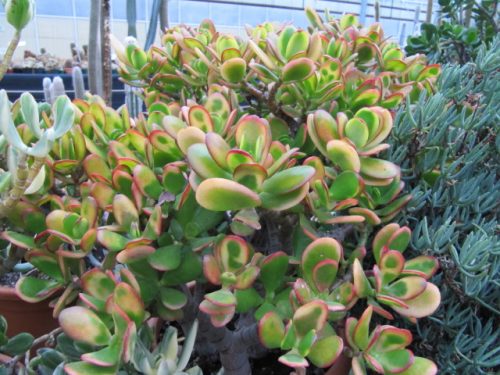

General problems
The tree does not grow
With proper care, a fat woman will grow in your home for 10, 20, and in some cases even 50 years. All this time, it increases in size, and only you can decide whether to cut its crown every year or let it stretch out over the entire window sill.
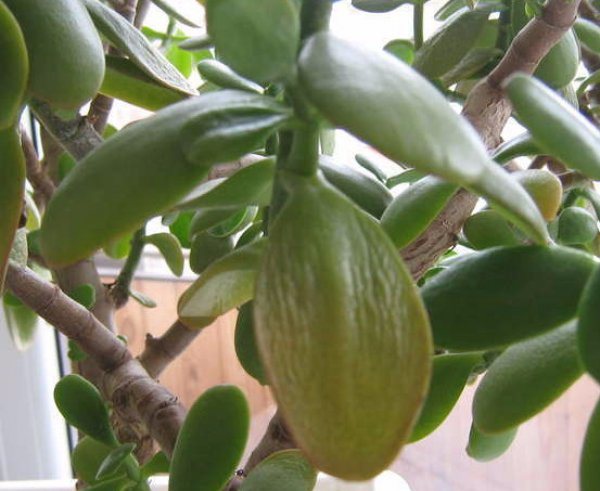

But what if you diligently water and fertilize the tree, and it looks like it is made of plastic - it remains in its old size? The problem is in the roots. Surely the pot for the plant was chosen shallow and not wide, so the money tree did not take root well.
Transplant your pet into a larger "bucket". But when transplanting, take a good look at the rhizome - sometimes it is shortened by rot, and sometimes by pests that have settled in the ground. In this case, cut off the rot, completely replace the soil, and poison the pests with an insecticide. And be careful: if the root is broken during transplantation, this will affect the growth of the fat woman even worse.
The stem of the money tree is pulled out
Crassula's long, curved branches can form from malnutrition. The fact is that, like all succulents, the fat woman does not like feeding with nitrogen. If you water it with nitrogen compounds, the branches will begin to stretch in different directions, and the leaves will not have time to form, and the crown will look poor and ugly.
If the branches are already extended, they can be pinched and / or pruned. This is best done in the spring. Not only long apical shoots are subject to removal, but also extra small branches inside the crown.
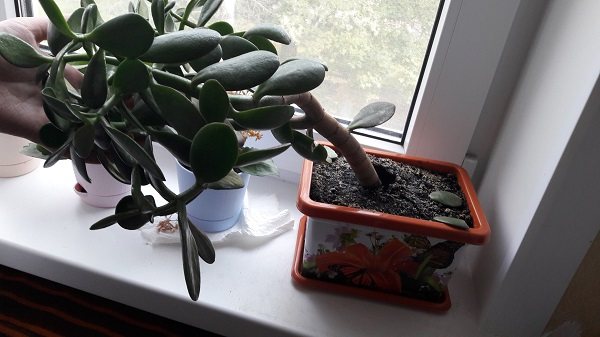

But what if the stem is normal, plump, and the tree itself falls on its side, that is, falls? Here the problem is in the soil that is too wet, which does not hold the trunk. Do not water it so thoroughly, because of the excess moisture in the pot, rot can start! And for the fat woman, make a support. Over time, when the green pet gets stronger, you will remove it.
The leaves have become soft
There may be several reasons:
- excess moisture in the pot, due to which the plant has developed rotting (the most common problem);
- the temperature in the room is not suitable for the tree;
- the fat woman really lacks light.
Root rot is shown in this photo (as you can see, the roots have completely rotted away, despite the fact that the upper part of the plant seems to be completely healthy):
Read also: Spathiphyllum Domino: plant care
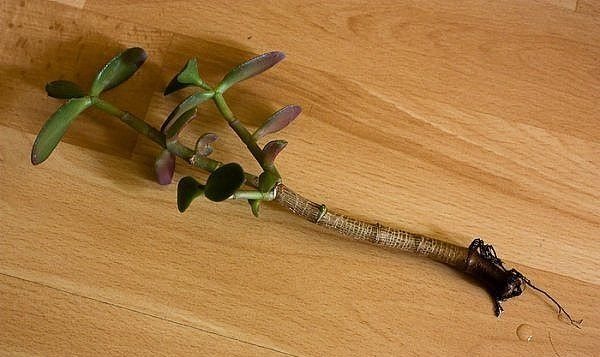

Rot is treated like this: Crassula should be urgently dug out of the pot, the roots should be gently rinsed. Cut off everything rotten - roots, parts of the stem, leaves. It is better to sprinkle the sections with crushed coal, it will prevent bacteria from entering the wound and aggravate the condition of the tree. Then plant the tree in fresh soil (take a new pot or disinfect the old one with at least boiling water). For insurance, pour the carbendazim solution over the soil. In the early days, shade and do not water the fat woman.
The tree withers, turns yellow, and then dries
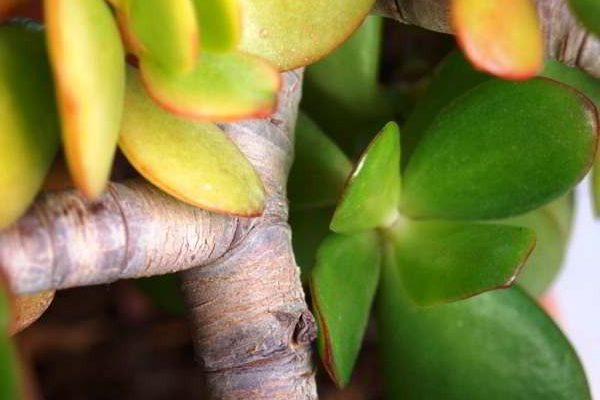

This is a "complaint" about the heat.
If you can, expose the money tree to fresh air (open veranda, courtyard, unglazed balcony), but so that the sun does not fall directly on the leaves.
Some people plant a fat woman in a flower bed or in a vegetable garden. The plant likes it. Just bring him back to the room in time. As soon as the temperature drops below 15 degrees on autumn nights, dig up the tree and plant it in the pot again.
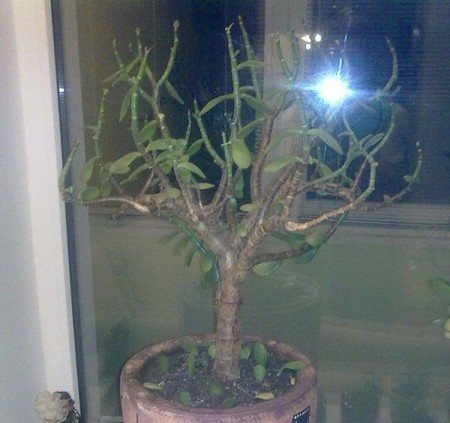

It can start for various reasons:
- this is a natural process (some fat women spontaneously “go bald” every 2 years, and then grow new leaves);
- you pour over the tree and it begins to rot (I already wrote about rot above);
- you water the crassula with cold water, and this is a reaction of the roots (it is correct to water the tree with settled water at room temperature or slightly lukewarm);
- you have not watered the tree for a long time, and it has thrown off the "ballast" that cannot "feed" - in this case, the leaves will first dry up and then fall off;
- the money tree suffers from direct sunlight - in this case, before falling, the leaves will turn red.
Crassula withers and loses leaves
Thin, soft, wrinkled leaf plates are a sign of illiterate watering. You either dried the tree (or maybe the room is too hot, and the sun immediately steals almost all the water poured into the ground), or vice versa, you often overflow it and the roots grow in swampy ground.
Look at the situation. If there is not enough water for the tree, water it more often (if you constantly forget about it, buy an aquaglob or other automatic watering). If you are overflowing a jellyfish, transplant it by adding more drainage to the bottom of the pot.
By the way, about the transplant. If the tree wilted immediately after being transferred to a new pot, it is quite possible that the problem is in the roots damaged during this manipulation. Shade the tree and water it very carefully - it may still go away.
Leaves turn yellow and fall
As with other problems, there can be several reasons for the yellowing and loss of jellyfish leaves.
- Watering with cold water. And if you also overfill your green pet, you will get an additional "package" of problems: fungus, mold.
- Lack of light. The trees growing in the northeast or north window fall into the risk zone. And if in the summer the sun looks even a little through such a window, then in the winter you definitely cannot do without additional lighting.True, I noticed: if there is always someone in the room in the evenings and the main lighting lamp is on (the flowerpot is not covered with a curtain), you can do without buying a phytolamp.
Attacked by pests
Yellowish, reddish spots
Most likely, your Crassula was the victim of an attack. scale insects
- harmful insects that suck the juice from the leaves. This diagnosis will be confirmed if the leaves begin to turn yellow and fall off, or you see the insects themselves (round red "plaques").
Your actions:
- Place the money tree away from the rest of the flowerpots. All home flowers (including bouquets) meticulously inspect for harmful "plaques" hiding from the inside of the leaves.
- We remove adult insects by hand. The pot with the tree should be placed in the sink (if the plant is small) or in the tub. With a small brush or cotton swab dipped in an insecticide solution (or alcohol, kerosene, soapy water), dump each pest and flush it down the drain.
- Treat all leaves with soapy water. But this should only be done if the infection is minimal.
- If everything is bad (or you just don't want to risk it), immediately cover the flowerpot with an insecticide solution. This substance is considered moderately hazardous, so all work should be carried out on an open balcony so that relatives do not breathe. And you should protect yourself by covering your face with a handkerchief, your hands with gloves, and your eyes with glasses.
The treatment should be repeated a week later. And if necessary, then another 7 days after that.
"Vata" in the axils of the leaves and / or at the base of the plant
White plaque is traces of vital activity mealybug
, whitish winged insects.
Remove them mechanically (in the same way as the scabbard), and treat the plant with either soapy water or insecticide.
Yellowish spots + cobweb
I came to the leaves of your fat woman spider mite
.
These insects are very small, black or red. The more cobwebs they lay, the worse, because pests hide their future offspring in the web.
Together with aphids, gray rot (fungal disease) often attacks the flowerpots.
If there are not enough cobwebs, the pot can be sprayed with soapy water. If a lot - acaricide (poison from ticks). Florists praise Aktofit, Fitoverm, Aktellik very much.
By the way, mites are afraid of dry air. So if you make it a rule to spray your house plants often, these pests will never bother you.
More about proper care
, thanks to which it is possible to minimize the risks of the appearance of all the diseases listed above, you can hear in this video:
It rarely happens that home flowers always stand vigorous and completely healthy. Sometimes it happens that their growth slows down, leaves begin to fall off them, or something like that happens. Such things should not happen to healthy plants. We understand this perfectly, and therefore we begin to look for the reason why our plant suddenly became mocked. The money tree also does not always grow perfectly. Diseases sometimes visit him. The fat woman (this is the second name of this plant) also has enough problems. And basically we ourselves create these same problems for the plant. Hence the disease.
Houseplants Directory


Why did the fat woman wrinkle the leaves?
The fat woman is a familiar money tree for all of us. This tree comes from Africa and Madagascar. This explains the plant's attachment to dry conditions and its aversion to excessive moisture. It is also worth emphasizing that the fat woman or the money tree loves a lot of sunlight. The inconsistency of the conditions in our apartments with the conditions in Africa is sometimes the cause of problems with this flower. And most often, flower growers are faced with the problem of wrinkling or falling foliage.
Let's figure out what can cause this behavior of the plant and find the answer to the question: "Why did the fat woman wrinkle the leaves?"
Cobweb mite.
This parasite is very easy to identify - by the characteristic cobweb on the plant.It can also be seen lying down by looking at the plant - you should see a gray or red dot moving along the leaf.
The cobweb mite is very afraid of high humidity. You can fight it with the folk method:
- give your plant a warm shower.
- Prepare a soapy solution using laundry soap.
- Foam the solution and apply the foam to the leaves and trunk.
- wash off the foam
- place the plant under a hood or plastic bag to maintain moisture.
- it is better to repeat the procedure again after a week.
My flower garden!
Recorded on 11/26/2013 Author Irina
The diseases of the bastard are basically the same as those of other succulents. They are usually caused by bacteria and lower fungi. They most often affect plants kept at a lack of light, high humidity and soil substrate, as well as at low temperatures.
Most often, a combination of these factors unfavorable for the content of fatty plants is observed in winter, when, with a short daylight hours, high humidity remains in rooms where succulents are kept. The plant does not rest, grows, and, as a result, pathogens of various diseases settle on it.
These are primarily wet or gray rot caused by the fungus Botrytis cinema and fusarium rot when attacked by the fungus Fusarium oxysporum. These fungi attack the vascular system of plants and penetrate deeply into the soft tissues of all organs through the roots. Diseased specimens have characteristic brown soft patches that gradually cover the entire plant, and eventually it dies.


Arrangement of succulents: tiger faucaria, perforated fat woman and cactus (lobivia)
To prevent the spread of the pathogen to healthy plants, it is necessary to drastically reduce watering and increase ventilation. In affected specimens, it is necessary to cut off diseased areas in layers to living tissue. Before each subsequent cut, the instrument must be disinfected.
Other diseases of the bastard and all succulents in general are the well-known late blight (pathogens are oomycetes of the genus Phytophthora), which develop on the root collar of young plants (especially those grown from seeds - as a result, black leg disease). For prevention, crops are periodically watered with a slightly pink solution of potassium permanganate.
The causative agents of bacterial rot are less studied. This is partly due to the complex procedure for identifying pathogen bacteria, partly to the rather expensive chemicals used in the diagnosis.
The external manifestation of bacterial lesions on plants is practically indistinguishable from those in fungal diseases. At the same time, fungicides are also used to combat bacterial rot, and the affected plants are treated as described above. You can also use antibiotics (penicillin, gentamicin and others) by spraying diseased plants with their aqueous solutions.
With the wrong content, the disease of the fat woman may not appear at first, but the appearance of the "money tree" will begin to lose its attractiveness. So, with an excess of moisture in winter or a lack of light in summer, the stalk of Crassula (the Latin name for a fat woman) can stretch and bend ugly. It must be remembered that the indoor flower we are considering needs a certain amount of direct sunlight in the summer, it is best placed on the windowsill.
Watering the money tree in winter is very rare: 1 - 2 times a month, depending on the air temperature (the optimal winter temperature is 12 ° C).
If the fat woman's leaves fall, then this is again caused, in all likelihood, by mistakes in care. Take a closer look at the money tree. Dry brown or black spots on the leaves of the bastard indicate insufficient watering at high air temperatures. If the fat woman has pale leaves, and they wither, there is an excess of moisture, especially in winter.
If, from waterlogging, the stalk of the fat woman turns black at the base, rotted, you have nothing to do but cut off its top, root it and continue to avoid excessive watering in winter.
The sudden fall of leaves in a fat woman can be caused by watering the plant with too cold water; in the future, water your money tree only with settled water at room temperature. In summer, the leaves of the bastard fall in large quantities, if the substrate is very dry, resume watering, the crown will gradually recover.
In general, the bastard is a rather unpretentious plant, it multiplies easily. A new copy can be obtained even from one small leaf (see photo below).


Fat woman who grew out of a fallen leaf
Pests of the bastard are quite numerous, but they rarely settle on a healthy plant, in addition, it is easier to fight them than viral, bacterial or fungal diseases. This is due to the easier detection of insects in the early stages of damage and clearer recommendations for dealing with them.
In addition, a plant affected by a pest can almost always be saved, which cannot be said about plants affected by fungi, bacteria and viruses. In any case, the main preventive measure in pest control is regular and timely careful inspection of plants. Consider the most common pests of succulents (and, in particular, fat women) and measures to combat them.
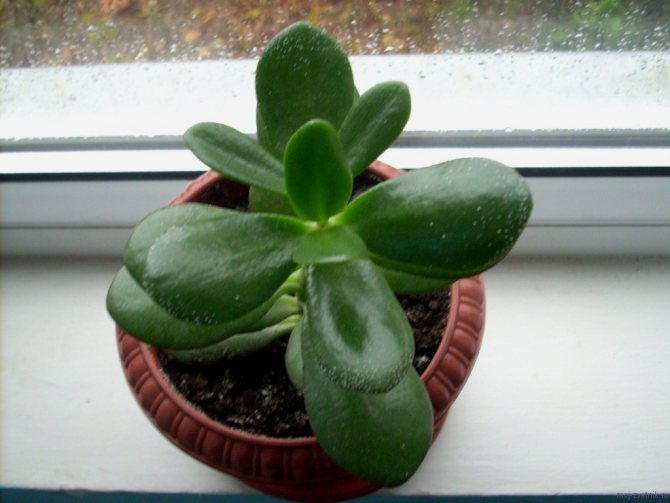

Fat woman oval
Mealybug.
A large group of insects of the genus Pseudococcus (for example, P. obscurus is a seaside mealybug), Planococcus (P. citri is a grape mealybug and others) are widespread polyphages that live on almost all ornamental plants in indoor conditions.
Females are broadly oval, pinkish or greenish, up to 4-5 mm in length and 2.8 mm in width. When ripe, the female forms a white fluffy cocoon, where she lays up to 600 eggs. 3-4 generations can be formed during the season. Settling in the axils of leaves and branches, insects suck it out and greatly weaken the plant.
Pests are destroyed by hand, washing off with a stream of water, followed by treatment of the affected areas with an alcoholic infusion of garlic or calendula (3 parts of 70% alcohol are taken for 1 part of garlic).
Of the chemical means of protection, spraying with a solution of actellik or fufanon (0.1-0.15%) is used. In this case, the treatment is repeated several times with an interval of 5-7 days in order to destroy all new generations of larvae emerging from the eggs.
Root worm.
A fairly common and dangerous group of root parasites of the genus Rhizoccus (R. dianthi, R. cacticans, R. falcifefm). These pests of the bastard live on the roots and root collar of the host plants and in the soil near the roots. The female is broadly oval, completely covered with white powdery wax, looks snow-white, 1.5 to 2.0 mm long and 1.0 to 1.3 mm wide. The larvae develop in white, cotton-like secretions and quickly become mobile.
With abundant watering, the insects move into the lower layers of the soil, crawl out through the holes of the pots and, quickly spreading around, infect other plants.
Control measures are difficult due to the constant habitation of the worm in the soil, as a result of which it is also difficult to detect. During a spring transplant, if the parasite is found, the safest way is to rinse the root system under a strong stream of warm water (up to 50 ° C).
An effective way is to wet the soil from the pallet without shaking it out or pour it on top with a solution of actellik (0.2%) or fufanon (0.1-0.15%). Do this several times in 5-7 days to destroy all the larvae.
Shields and false shields.
Close relatives of scale insects belonging to the genera Saissetia (S. olea - olive scutellum, S. coffeae - hemispherical scutellum), Acutaspis (A.persea), Abgrallaspis (A. cyanophylli) and others. Females of all genera form grayish-white or yellowish scales-scutes on host plants, sometimes being located in large colonies.
Under such a wax shield, they lay up to 100 eggs, from which tramp larvae emerge. They crawl over the plant for some time, and then stick to it, forming a shield. Thanks to the protective coloration, such shields can go unnoticed for a long time. At the same time, it is quite difficult to fight this parasite, since the shield can withstand almost any chemical attack.
The main control measure is manual scraping of the shields, followed by treatment of the affected areas with an alcoholic infusion of garlic, celandine, a solution of coniferous extract (1 teaspoon per glass of water) or kerosene. They also use a solution of laundry soap, a zoo shampoo against exogenous parasites "Bim" or a household preparation for disinfection and dishwashing "Ferry".
In case of severe infection, the listed pesticides and preparations of the pyrethroid series are also used, of which the safest in room conditions are Arrivo, Cymbum (0.15%) and Karate (0.05%). In this case, the processing should be repeated with an interval of 1-2 weeks. It is possible to use the biological preparation "Fitoverm". These drugs are especially effective on vagrant larvae.
Spider mites.
The collective name for plant mites of the Tetranychidae family. Some species are called flat red mites or spiders, red spider mites, etc. Unlike those previously discussed, these are very small pests, but the damage they cause is the most significant and unpleasant.
Females up to 0.3 mm long move rather quickly along the surface of the plant, breeding year-round, especially in dry air. They also differ in that they often settle in a fresh growth, where the cuticle is the thinnest. In places of their localization, the skin of the stems and leaves turns yellow and turns brown, then a rusty or brown crust forms, which not only spoils the appearance of the plant, but also disturbs its shape. At the same time, ticks quickly spread from the affected plants to healthy plants, causing great harm to them.
If spider mites are found, it is urgent to increase the humidity of the air by spraying. The affected plants should also be sprayed and doused with a stream of cold water. It is good to use the infusion of yarrow, garlic, onions, tobacco, potatoes, chamomile in the pharmacy. Among biological means of control, one should name the predatory phytoseiulus mite - Phytoseiulus persimilis, which willingly eats the flat heifer.
All disinfecting soap preparations of household chemicals and pyrethroid preparations used to combat the scabbard are also used against ticks, as well as the new drug "Apollo" that effectively destroys the pest.
Greenhouse flat beetle.
Flat-calf mite Brempalpus obovatus of the family Tenuipalpidae. Close to spider mites; the control measures are the same.
Nematodes.
The general name of some genera of microscopic small filamentous worms that settle in the soil and parasitize on the roots of the cactus nematode (Heterodera cacti - cactus nematode, s Meloidogyne arenaria - gall nematode, etc.). In the places of their penetration, characteristic swellings, called galls, are formed on the roots from plants.
Close examination can also detect nematode cysts in the ground. Outwardly, a plant infected with this parasite may look healthy, but growth retardation, as well as unusual swelling on the roots, most often indicate the presence of this dangerous pest.
As soon as the named pests of the bastard are detected, safety measures must be taken immediately. First of all, cut off diseased roots, sometimes to the root collar, or, alternatively, cut the plant and root it again.
After that, it is imperative to disinfect tools that have come into contact with the infected plant and soil, as well as pots. All infected parts of the plant, the land in which they were located, must be immediately destroyed.
In the fight against nematodes, the antihelminthic drug "Pirantel" has proven itself quite well (it is inexpensive, sold in pharmacies). Its solution (250 mg per 10 l of water) is watered on diseased plants twice with an interval of 2 weeks.
Thrips.
In indoor culture, thrips emerged from open ground and greenhouse farms. Now these are the most dangerous plant pests. This includes representatives of the order Thysanoptera. These are Frankliniella occidentalis - Western floral thrips, or Californian, Heliothrips haemorrhoidalis - greenhouse or greenhouse thrips, Thrips physapus - floral thrips, etc.).
The adult insect is small, 1-2 mm long, dark brown or brown, elongated, with fringed wings and a black head. The eggs are laid in the tissue of the plant. The larva is light yellow, 1 mm long. Adult insects and larvae suck sap from leaves and flowers, deforming and discoloring them.
Mass propagation of thrips is observed during the flowering period, when it accumulates around the flowers. When buds appear, it penetrates inside, damaging the flowers, and in the fall, when the temperature drops, thrips move to the lower parts of the plant.
In addition to direct harm, thrips carry pathogens of some dangerous viral diseases. Its mass reproduction is observed in hot dry weather. One generation develops in 2-4 weeks. During the season, this pest gives up to 12-15 generations. The only good news is that at an air temperature of more than 35 ° C, the development of almost all thrips stops, and with a decrease in the relative humidity of air to 50%, mass death of larvae is noted, at least in well-studied species.
The following pesticides are most effective in the fight against thrips: actellic, fufanon (0.1-0.15%), as well as relatively new drugs - evisect and hotakvik. To combat thrips, you can also use the pyrethroid drugs Arrivo, Cymbum (0.15%) and Karate (0.05%). They are of low toxicity but can sometimes cause allergic reactions. The most harmless preparation in this regard, Fitoverm, is an extract of one of the soil fungi.
Aphids.
Optional (non-permanent) pests of succulents that usually live in open ground and get into the premises from there. Another, more relevant today, variant of the penetration of aphids into the collection is from flower shops and import deliveries of potted plants.
This is a widespread group of insects of the genera Aphis and Myzodes. Indoors on succulents, peach (greenhouse, or tobacco) aphids (Myzodes ersiçae), melon (cotton) aphids (Aphis gossypii) and spotted greenhouse aphids (Neomyzus circumflexus) are more common.
Aphids are the most well-known pests that damage the soft tissues of plants. Damaged parts often wrinkle, bend, and dry out if severely damaged. Sometimes young parts of plants can be covered with a continuous bloom of larvae and adult females. Adults are wingless or winged up to 2 mm long, wingless larvae are about 0.5 mm long. Both are dark green, brown, or black.
The eggs are elongated. They hibernate on a young growth of garden plants. In spring, the founding larva emerges from the eggs. The larvae suck on young leaves, moving on to the buds. Larvae develop for 12-15 days. During the summer, aphids give 10-15 generations. In the summer period, winged settler females develop simultaneously with the wingless ones, which migrate, populating new territories and sometimes getting into the premises. In September-October, aphids lay eggs and die.
One of the measures to combat the pest is mechanical washing with solutions of green soap (3-4%), laundry soap, "Bim", "Ferry" and other detergents.
From biological control methods, the use of predatory insects that destroy aphids can be advised. However, the most effective chemical method is with the use of pesticides used to control other indoor pests of the bastard.
Other pests of the bastard in indoor conditions are red cockroaches, gnawing young parts of plants - shoots, flowers, seedlings. The fight against cockroaches is carried out both with the help of widespread household preparations, and with the help of the previously listed pesticides, including the well-proven actellic.
Snails, wood lice, slugs can cause significant damage to succulents in the house and garden. They must be collected and destroyed in time. Raw potatoes, citrus peels, etc. can be used as bait for these pests.
In the open field, mainly herbivorous rodents harm the bastards, among them mice, voles, and rats should be mentioned. They gnaw and eat various parts of plants, they can also feed on seeds. Methods for controlling these pests are widely known.
Concluding the conversation about the diseases of the fat woman and its pests, it must be emphasized once again that the most effective way to avoid them is to observe those optimal conditions of agricultural technology (temperature, light, humidity and soil fertility), in which the money tree feels good, looks healthy and does not get sick. It is also necessary to observe hyenic measures that prevent the spread of diseases and pests: disinfection of soil, tools, dishes, cleanliness of plants.
A constant preventive examination is necessary for the timely detection of sick or pest-affected plants and the prevention of contamination of neighboring healthy specimens.
It is also useful to periodically treat plants with a weak solution of potassium permanganate or infusion of calendula, tobacco, yarrow, etc. When pathogens or pests are found, a mechanical method of control should be used first of all: rinsing with water and smearing with alcoholic tinctures (garlic, onion, celandine, pine needles), and also hot tubs for the root system. And only as a last resort, you can use chemicals, remembering that most pesticides are toxic not only to pests, but also to humans, and some of them can cause allergic reactions.
Chemical treatment should be carried out only in a well-ventilated area, preferably outdoors, observing safety measures.
When keeping bastards in the open air, specific indoor diseases and pests are added to such specific ones as rodents and other vertebrates - birds, lizards, moles, as well as slugs (mollusks) and insects characteristic of open ground. Therefore, you need to carefully monitor the plants in the garden, and, if necessary, take timely measures to protect them. We hope that the topic of fatty disease in our article is fully disclosed, but you can always ask additional questions in the comments.
Did you like the article? Share with your friends
General questions about plant care plant diseases and pests, houseplants, succulents
- ← Red sea buckthorn - what kind of plant is it?
- Live Christmas tree in a pot →
Shield.
It is very difficult not to notice the scabbard on Tolstyanka, it looks like such a tubercle, as in the photo above. It is better to remove insects from the plant by hand, and destroy, treat the plant with soapy water and use a chemical agent against the scale insect - Fitoverm. The instructions describe a detailed guide to action.
If you did not find the answer to your question - ask it in the comments, we will try to help you.
Crassula has strong immunity against various kinds of diseases, therefore most often the problems that have arisen are associated with improper care or inappropriate location of the pot. To determine the cause of the disease, it is necessary to carefully examine the flower and compare the external sign with one or another negative content factor. In the article below, we will describe the diseases of the fat woman with photo examples and figure out how to deal with them.
Fatty's leaves have lost their elasticity. Why do the leaves of the Fat woman wither?
Fatty girl withers also for various reasons. First, it can be simple tightness in the pot, when the roots have already occupied the maximum space in the container, in this case you can solve the problem by transplanting into a more spacious pot.
Secondly, the reason that the Money Tree withers can be improperly adjusted watering... When bay, the roots of the plant crack and begin to rot, along with them the trunk begins to rot, from this the leaves wither and wrinkle. Simply by reducing watering, the problem, alas, cannot be solved... It is necessary to get the plant out of the pot and examine its root system. If the earthy clod around the roots is wet and the roots are rotten, then they will have to be removed. You need to use new soil for the Fatty, and henceforth do not water so abundantly. Unfortunately, Crassula transplant is not a guarantee that she will survive... If over time she does not get better, we advise you to break off the cutting and root it. Do not worry, succulents reproduce very easily.
Pest control and photography
Pests are not very fond of settling on Tolstyanka, but from time to time she suffers from their invasion.
Why does a white bloom appear on the fat woman (white spots or dots on the leaves): what is it?
Sometimes in the axils of the leaves of the money tree, you can see a white bloom, similar to cotton balls. This is a signal that a mealybug has settled on the plant. In order to get rid of it, you need to:
- wash off the pest with warm water from the shower;
- wash the fat woman with a small brush with a thick foam of laundry soap, then rinse the plant with clean water;
- process with infusion of garlic, or tobacco, decoction of cyclamen tubers. Such treatments are carried out 3-4 times a month.


The worm affects not only the Fat Woman, but also many other plants, for example: Hoya, Poinsettia succulent, Cereus cactus.
If you do not fight the worm, it will feed on the juice of young shoots, which will lead to the weakening of the plant, slowing down its growth, loss of leaves, and the appearance of a colony of sooty mushrooms on the Fatty. The white bloom on the plant must be rubbed between the fingers in order to distinguish a mealybug from a fungus infection.
A moldy smell indicates a fungal infection.
It is much more difficult to get rid of spider mites. Its presence can be seen by small yellowish spots on the leaves and spider webs.
The reason for the appearance of this pest is warm and dry air, so by spraying the plants regularly, you can avoid the appearance of a mite on the fat woman. In the early stages of the lesion, you can treat the money tree with garlic or tobacco infusion, soap foam.
Such measures are not always effective, most often neighboring plants are also affected by a mite.
In this case, only insecticide treatment will help. They need to process not only plants, but also the surface on which they stand, as well as flower pots to destroy the clutches of spider mite eggs.
The scabbard can be seen only at a late stage of the lesion, when red-brown plaques (spots) appeared on the bases of the petioles of the money tree and the back of the leaves along the veins, that is, the pest can be seen with the naked eye.
The following measures are urgently taken:
- scale insects are removed by scraping them from the surface of leaves and shoots;
- the fat woman is wiped with tobacco or soapy water, washed with warm water;
- the plant is treated with a systemic insecticide.
Causes of the combined problems and how to fix it if such symptoms appear?
Becomes soft, flaccid, wrinkled and thin
If they forget about the plant and do not water it for a long time, then leaves waste their reserves, become soft and thin... And when they suddenly remember about the flower and begin to actively water, the leaves immediately wrinkle.
It is necessary to choose the correct irrigation regime, avoiding such differences in the state of the soil. Otherwise, the flower will die from stress.
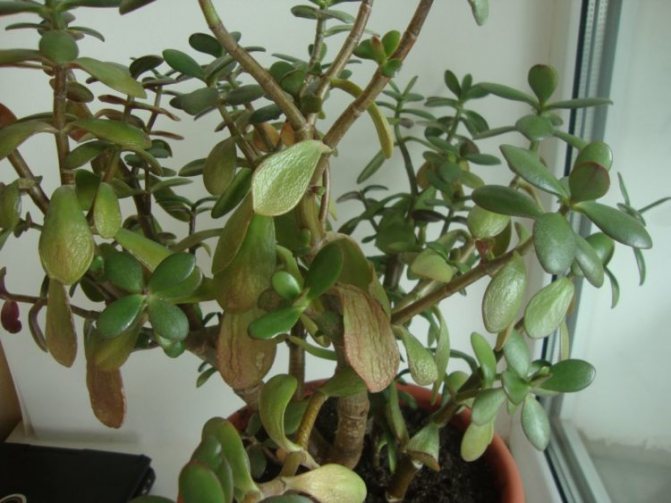

We offer you to watch a video about why a fat woman can have soft leaves:
Wrinkled and blushed
The combination of these factors indicates a lack of nutrition and excessive lighting. The flower should be shaded and fed with any complex fertilizer... And also it is good to spray with a biostimulant.


Soft and fall off
One of the reasons is watering directly from the tap. In this case, the water can be quite cold. The second possible reason is excess fertilizer.
To correct both deficiencies, when watering, you need to use only warm water, and cut the feeding.
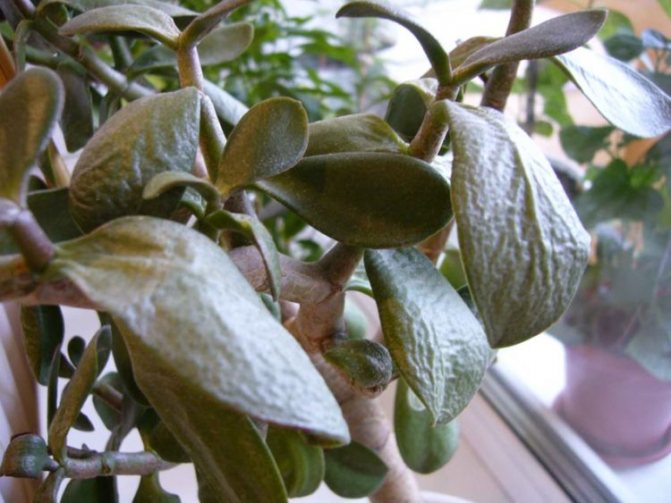

We offer you to watch a video about the reasons for the leaves falling on the bastard and how to eliminate them:
Dry and fall
When a similar problem occurs it is necessary to inspect the root system and at the same time dry the earthy clod.
If the plant is cramped in the previous pot, then its transplant is necessary.


We suggest watching a video about the causes of dry foliage on Crassula:
Wither and shed the foliage
Most likely, the flower was flooded, as a result of which the root system suffered. What if the leaves become soft and lethargic? It is necessary to dry the ground and increase the temperature of the content. If the drying of the earthen coma did not work, then a plant transplant is required... The roots should be freed from rot, rinsed in a solution of potassium permanganate and only then transplanted into a new soil.
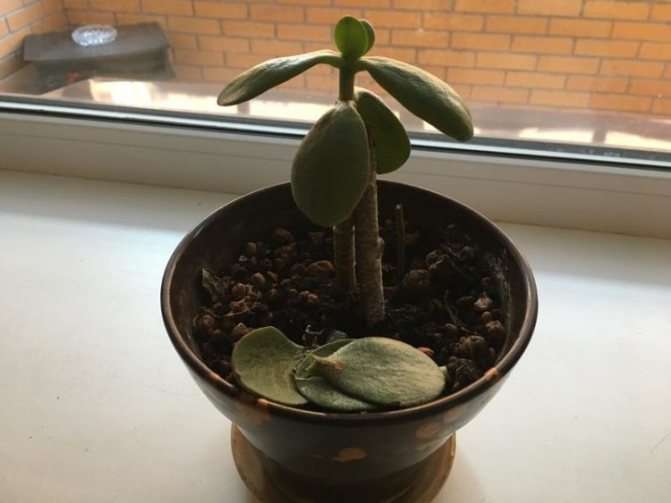

In order for the Fat Woman to please with a strong trunk and a beautiful lush crown, it is necessary to carefully monitor her care. Contrary to the opinion about the resistance of the plant, it does not tolerate carelessness and carelessness. The main thing is not to neglect watering, protect from bright sunlight and feed the flower in time.
If you find an error, please select a piece of text and press Ctrl + Enter.
—Labels
-Quotebook
The magazine "Gastronom" claims that this is exactly the case. But I would say that it is rather.
Today I offer you a recipe for marble curd with muesli. This cake can be served to.
What to do if frozen?
Signs that the culture is frozen will be noticeable even with the naked eye: if the fat woman wilted, its leaves became watery and thin, hypothermia became the reason for the deterioration of the tree's condition. Also, the experienced stress from hypothermia is manifested by a silvery bloom on the leaves. In order to save the plant, you need remove all damaged parts, and disinfect the cut points with crushed activated carbon... However, not only the aboveground part of the money tree can freeze, but also the soil with the rhizome of the succulent. In this case, it is necessary to remove the bastard from the pot, trim the affected roots and transplant it into new soil.
It will be possible to maintain the health of the plant after hypothermia with the help of treatment with the store-bought preparation "Epin"


Roots rot at Fatty Woman - the trunk softens, and the leaves shrivel.
If, when replanting your withering plant, you see that the roots of the Fat Woman darkened and began to rot, but you need to take a number of resuscitation measures, otherwise the plant will die very quickly.
So, firstly, rinse the roots of the Fatty Woman under a stream of warm water. Second, remove the damaged areas of the roots. Thirdly, prepare a weak solution of potassium permanganate and place the Fatty Woman with the remaining roots in it for 15-20 minutes. This is necessary in order to disinfect healthy roots.
To summarize ...
- The money tree is an indicator of your wealth. If it's healthy, your income is normal. If it crumbles, you can't avoid spending. Well, if it dies, you will have to seriously tighten your belt.
- To make the tree become a magnet for money, bury three coins near the roots and / or tie a branch (trunk) with a red ribbon.
- If live flowerpots do not take root in your house, start an artificial money tree - from beads, coins or real dollars.
- The "colleague in the shop" of the fat woman is the plant zamiokulkas - the so-called dollar tree. It also multiplies the income of its owner.
Do you want your fat girl to grow up healthy and lush and never crumble? The tree must be properly looked after. This girl will teach you how to do this. Proof that she knows how to handle Crassula is her well-groomed, flowering plant:
The fat woman is losing leaves - why would it
If a plant begins to suddenly fall of leaves, this indicates that your house has poor energy. First, try to move the pot with a flowerpot to another window sill, to another room - maybe the energy field is better there.
In general, esotericists like Crassula very much. They believe that its thick leaves emit positive energy, "healing" the space around them. That is, if the tree is sick, then the negative in the house or room is so strong that even it cannot cope.
And if Crassula is at the same time high and branched, that is, the strongest possible, you need to think about whether you live in constant quarrels and scandals. After all, even if the flowerpot is sick from this, then what can be said about the children!
In addition, in most cases, falling Crassula leaves warn you of impending financial losses. Especially about spending is not green, but silvery leaves.
Some people say: the fallen leaves must be counted. How many pieces have fallen, your income will decrease by that percentage.
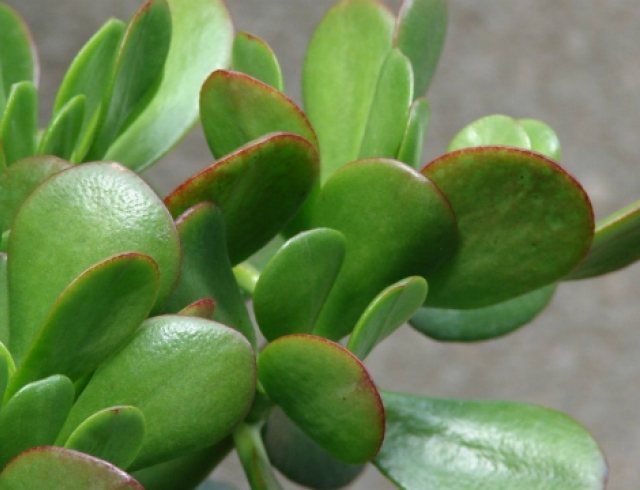

And if the tree is completely dead
It’s bad: you’ll be bankrupt. But this interpretation is possible only if you have been caring for a fat woman for a long time. In this case, the tree is completely connected with your energy and can predict the future.
If the plant was bought a month or two ago, its death speaks of only one thing: it simply did not take root in your home (or maybe you have not fully figured out the rules for caring for succulents).
Important! When throwing away a dead tree, do not forget to remove the coins buried near the roots, otherwise you will “throw away” your income with them.
But while you can, try to heal the diseased plant. Maybe you can still get it out - together with the tree, you will improve your financial future.
This video will tell about the diseases from which the fat woman suffers, as well as their treatment:
Sometimes the fat woman "withers", bending under her own weight. This sign says: your income will not run out, but their flow will become smaller.
Has the tree fallen? Did it break at the same time? If so, this is a waste or loss of income.
Well, if someone knocked down a tree, but it did not suffer, then everything is fine! Your income will grow. Not even so - they will take off!
However, if the tree remains intact, and the pot is cracked or the earth spilled out of it, an increase in income will be associated with the appearance of troubles.
Plant restoration
To restore the original appearance of the leaves, you can do two things:
- 1 Move the plant to another place where there is no direct sunlight.
- 2 Cover the window with a curtain or gauze when the light is bright.
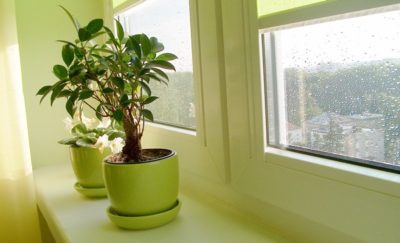

And after a while, the owner will notice that the tree has turned green again and restored its original healthy color. But if the leaves not only turn red, but also wither, then you should take the treatment more seriously. Here, one permutation will not be enough. You will also need to fertilize with fertilizer or biostimulant, which will speed up recovery. It is also important to water in a timely manner. In normal weather, the plant should be watered once a week, if it is too hot in the house and outside, then it can be twice.
Care
For home care, no special knowledge is required. The place for the flower is chosen from the south side. It should be spacious and well-lit. In late spring and early autumn, in warm weather, the tree can be taken out into the fresh air. In summer, the culture can withstand heat well at 20-25 degrees, but spraying is required. In winter, the temperature in the room is maintained at 10 degrees, but the fat woman can withstand 0 degrees.
Watering in the summer is carried out as the soil dries up. Water is taken at room temperature. In winter, it is rarely watered, the soil is moistened to a depth of 2-3 cm. The money tree must be regularly sprayed with water and wiped off the leaves with a damp sponge. This gives them elasticity and oxygenates them.
The culture does not need constant fertilization.Top dressing is carried out once during the growing season. It is not carried out at all in autumn and winter. The root system is in the upper layers of the earth and can be burned with drugs. Therefore, the liquid fertilizer is diluted in water and watered on moist soil.
Cotton-like formations in the axils of the leaves of the plant, around the root collar and on the stems
This nature of the defeat indicates the presence of a mealybug on your money tree. These winged insects of white color, 3-6 mm in size, drink the juice of young shoots and leaves, as a result of which they stop developing, deform, and the leaves fall off.
Read also: How to make a hose reel
With a slight spread of the pest, it is removed mechanically with a brush dipped in soapy water. Then the whole tree is treated with soapy water. If there was a mass invasion of mealybugs, the plant should be treated with Aktelik, Calypso, Fitoverm, Biotlin and others.
In order to avoid diseases of the money tree and their treatment, it is necessary to take preventive measures to prevent them and responsibly follow the recommendations for planting and growing the plant.
There is a belief that if a person falls ill in the apartment where the fat woman grows, then the plant begins to wither and get rid of the foliage. After a person recovers, the money tree also returns to its healthy appearance. However, as we can see, the cause of wilting and shedding of foliage is precisely the diseases of the fat woman. Having familiarized yourself with their causes, you will be able to timely eliminate adverse factors, provide assistance to the plant and save it from death.


